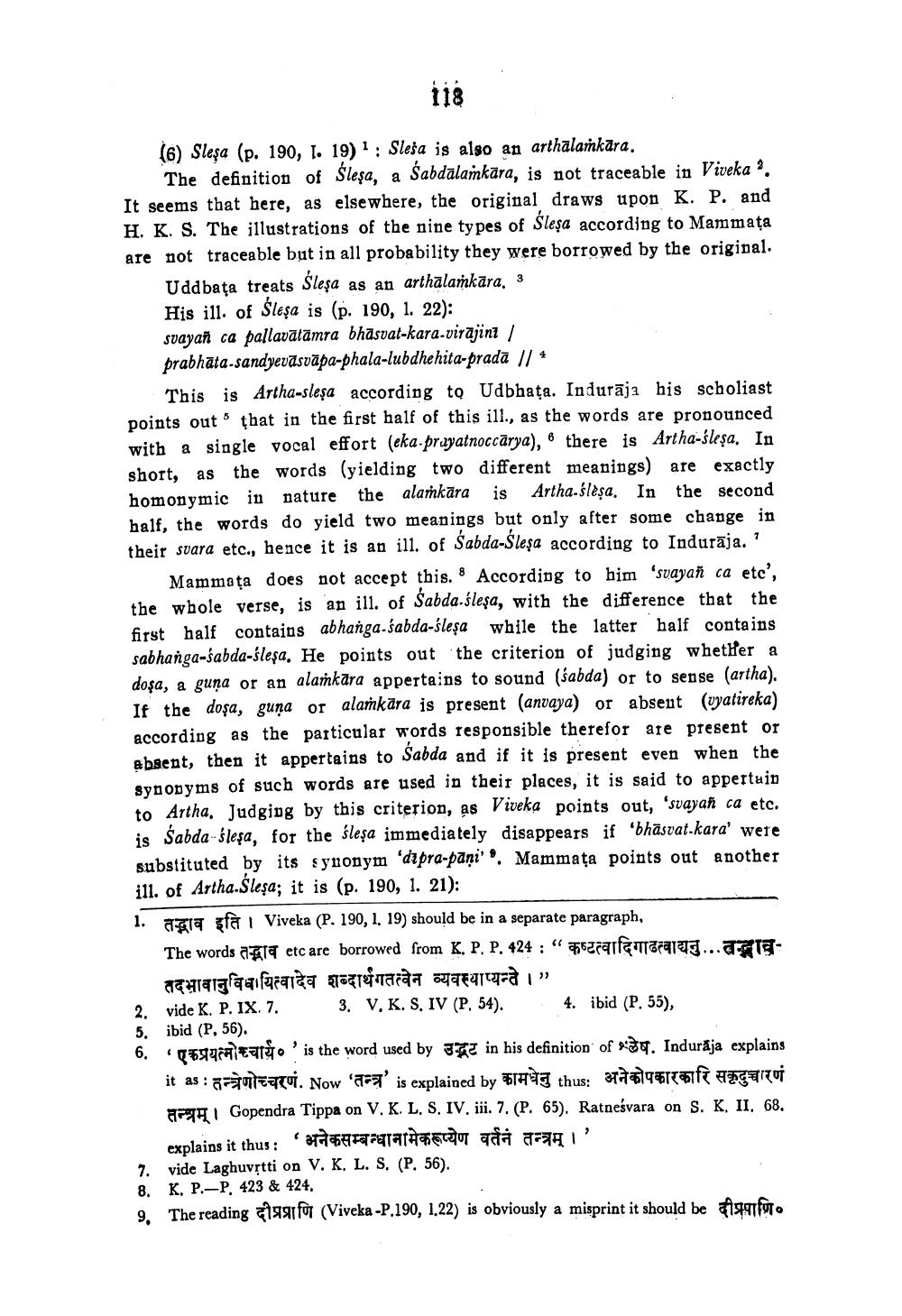________________ (6) Slesa (p. 190, 1. 19) 1 : Slesa is also an arthalamkara. The definition of Slesa, a Sabdalamkara, is not traceable in Viveka". It seems that here, as elsewhere, the original draws upon K. P. and H. K. S. The illustrations of the nine types of Slesa according to Mammata are not traceable but in all probability they were borrowed by the original. Uddbata treats Slesa as an arthalamkara. 3 His ill. of Slesa is (p. 190, 1. 22): svayan ca pallavatamra bhasvat-kara-virajini / prabhata sandyevasvapa-phala-lubdhehita-prada // 4 This is Artha-slesa according to Udbhata. Induraja his scholiast points out that in the first half of this ill., as the words are pronounced with a single vocal effort (eka. prayatnoccarya), e there is Artha-slesa. In short, as the words (yielding two different meanings) are exactly homonymic in nature the alarkara is Artha-slasa. In the second half, the words do yield two meanings but only after some change in their svara etc., hence it is an ill. of Sabda-Slesa according to Induraja.' Mammata does not accept this. According to him 'svayan ca etc', the whole verse, is an ill. of Sabda-slesa, with the difference that the first half contains abhanga-sabda-slesa while the latter half contains sabhanga-sabda-slesa. He points out the criterion of judging whether a dosa, a guna or an alaskara appertains to sound (sabda) or to sense (artha). If the dosa, guna or alaskara is present (anvaya) or absent (vyatireka) according as the particular words responsible therefor are present or absent, then it appertains to Sabda and if it is present even when the synonyms of such words are used in their places, it is said to appertuin to Artha. Judging by this criterion, as Viveka points out, 'svayah ca etc. is Sabda-slesa, for the slesa immediately disappears if 'bhasvat.kara' were substituted by its synonym 'dipra-pani'. Mammata points out another ill. of Artha.Slesa; it is (p. 190, 1. 21): 1. a ra fa i Viveka (P. 190, 1. 19) should be in a separate paragraph, The words ata etc are borrowed from K. P. P. 424 : " farfemarajag...GE तदभावानुविधायित्वादेव शब्दार्थगतत्वेन व्यवस्थाप्यन्ते / " 2. vide K. P. IX. 7. 3. V. K. S. IV (P. 54). 4. ibid (P. 55), 5. ibid (P, 56). 6. 'एकप्रयत्मोच्चार्य' is the word used by उद्भट in his definition of लेष. Induraja explains it as :तन्त्रेणोच्चरणं. Now 'तन्त्र' is explained by कामधेनु thus: अनेकोपकारकारि सकृदुच्चारणं THI Gopendra Tippa on V. K. L. S. IV. iii. 7. (P. 65). Ratnesvara on S. K. II. 68. explains it thus : 74710TAE ada 94? vide Laghuvitti on V. K. L. S. (P. 56). 8. K, P.-P. 423 & 424, 9. The reading alagt for (Viveka - P.190, 1,22) is obviously a misprint it should be safe




